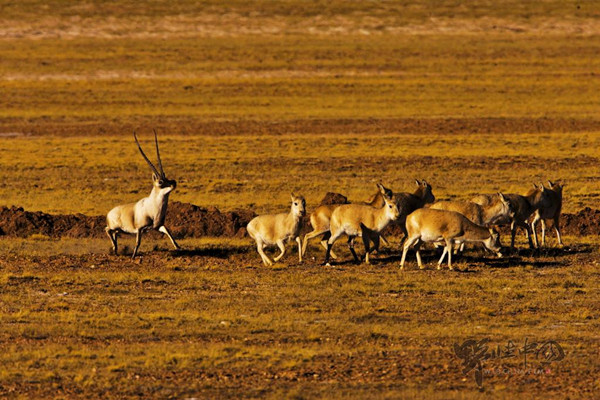Plateau guardians
 0 Comment(s)
0 Comment(s) Print
Print E-mail China Pictorial, September 4, 2013
E-mail China Pictorial, September 4, 2013
 |
|
Tibetan Antelope(Pantholops hodgsonii), Kekexili, Qinghai, December 2006. [Photo/Xi Zhinong/WildChinaFilm] |
Every year, frequent mountain patrols from November through July, are scheduled and assigned by the administration of Hoh Xil National Nature Reserve across an area of 45,000 square kilometers to monitor living conditions of wild animals such as Tibetan antelopes, wild yaks, kiang (Tibetan wild ass), Tibetan gazelles, and migratory birds. Familiar with the Tibetan antelope's migration route and living patterns after years of mountain patrolling, the administration also dispatches staff to various conservation stations to guard the Qinghai-Tibet highway every May to ensure the safe crossing of pregnant Tibetan antelopes as they migrate to Zonag Lake to give birth.
"The measures taken by the administration have been very effective, and no poaching of the Tibetan antelope has been seen since 2006," declares Wang Dru Tai, a senior patroller who led a mountain team for many years. Recently, as the living environment in Hoh Xil has constantly improved, the population of Tibetan antelope in and around the nature reserve region has climbed to 60,000 – about 10,000 more than in 2006.
"Today, we are allocating greater resources to research work on ecology and managing the team scientifically instead of merely protecting wildlife from poaching and deterioration as in our early days," explains Tesda, secretary of the Party Committee of Hoh Xil National Nature Reserve Administration. "Even greater efforts will be made to protect Tibetan antelopes and their homeland: Hoh Xil."
About Hoh Xil:
Hoh Xil is an isolated region in the northwestern corner of China's Qinghai-Tibet Plateau. Covering an area of 45,000 square kilometers at an average elevation of 4,600 meters, Hoh Xil National Nature Reserve is one of the world's most primitive and well-preserved natural environments and ranks at the top of China's nature reserves in quantity of species. Despite its harsh climate, Hoh Xil is home to nearly 30 species of mammals, about 50 kinds of birds and six kinds of fish – all of which are endemic to the Qinghai-Tibet Plateau. With the snow leopard, kiang, wild yak, Tibetan antelope and white-lipped deer (Thorold's deer) composing the inaugural class of protected species, and the brown bear, lynx, Pallas's cat, jackal, stone marten, blue sheep, ovis ammon and Tibetan gazelle making up the second class of protected species, Hoh Xil National Nature Reserve is home to a total of 13 varieties of rare and endangered mammals along with eight species of rare birds including vultures, buteo (raptors), kestrel (falcons), Tibetan snowcocks and whooper swans.






Go to Forum >>0 Comment(s)